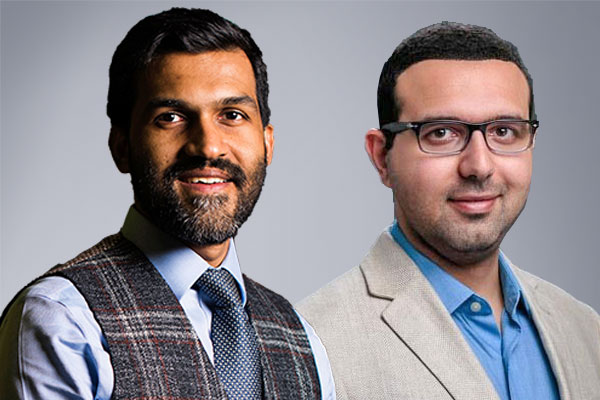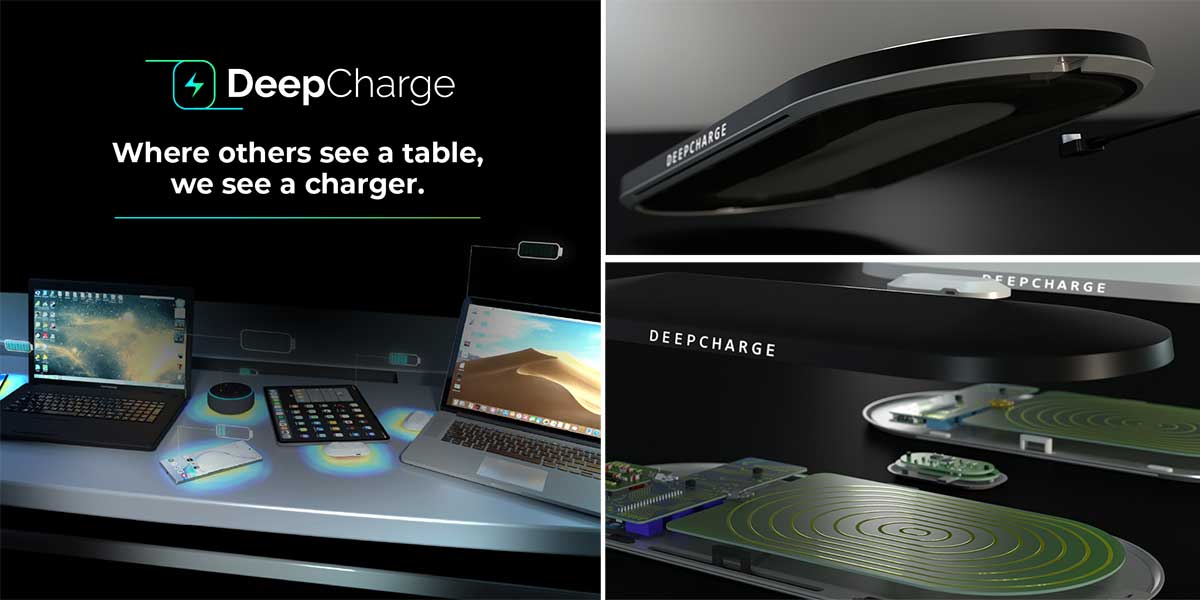DeepCharge Startup Transforms Surfaces into Universal Chargers

Main photo: DeepCharge, a startup spun out of a Northeastern College of Engineering lab, enables any surface to charge electronic devices.
For every electronic device you own, there’s one more charger to lose, forget, mix up with a different charger, or simply forget to plug in. But what if charging took up no more thought and effort than putting devices on your desk? What if it was the desk you work on?
For a pair from Northeastern’s College of Engineering, it wasn’t such a crazy question. Yousof Naderi was a PhD student studying under Kaushik Chowdhury, professor of electrical and computer engineering, when the two lit on an idea for charging as a basic infrastructure. Any surface—a desk, countertop, or even the floor—could become a universal charging surface: Simply lay the device on that surface, and the charging would commence. After developing their concept in Northeastern’s Next GEneration NEtworks and SYStems (GENESYS) lab, they went on to cofound a Boston-based startup—DeepCharge—in 2018. Beyond phones, tablets, and laptops, the technology could set a new standard for charging home appliances, power tools, drones, electric vehicles, and beyond.
“DeepCharge is, at heart, a Northeastern success story—and it comes from a very Northeastern ethos of experientially building things,” said Chowdhury. “The culture of this place is agile, innovative. You try to build things, see if they’re working—if not, you try something else.”
That’s how it happened for Chowdhury and Naderi—now a research assistant professor of computer engineering—who’d started their research on a somewhat different topic. Looking at the myriad sensors embedded in the Internet of Things, they pursued a concept for keeping those sensors permanently charged by harvesting cellular signals from the surrounding environment. That technology showed promise, yet they later switched gears: While cellular signals were sufficient for tiny sensors, larger devices would need a different energy source.
That’s how they turned instead to harvesting over-the-air RF signals, the model behind DeepCharge. From there, they looked at what they call the “fundamental architecture problem” in traditional charging models: the need to align the charging coils in the device and the charger, which limits devices to their dedicated chargers. They built their solution in the form of charging pads with patented AI sensing that locates devices wherever they’re placed on the surface, shaping the energy intelligently over the surface to channel the charge where needed. These pads can then be preinstalled under any desired surface, or added to existing surfaces.

Kaushik Chowdhury, electrical and computer engineering professor, and Yousof Naderi, electrical and computer engineering research assistant professor.
“Every surface is an opportunity for DeepCharge,” said Naderi, suggesting DeepCharge could become to charging what the Cloud is for storing and retrieving files: effortless and ever-present. “We’re going to have this infrastructure that we use daily to charge our devices, and not as an extra frustration point.”
Since its inception, Chowdhury’s and Naderi’s work has earned National Science Foundation funding through the NSF’s I-Corps program as well as a CAREER award. Along the way, though, it was also supported twice by crucial funding through Northeastern’s Center for Research Innovation. “Without these investments at critical junctures, we would not have the ability to scale this up,” said Chowdhury. Beyond funding, Naderi added, the effort has drawn from a full-fledged Northeastern “ecosystem”: Key mentorship opportunities, access to Northeastern’s Genesys Lab, and contributions from at least ten graduate students all helped transform their work from concept to startup. “Without Northeastern,” he said, “none of this would have happened.”
For future graduate students, Chowdhury added, DeepCharge shows how PhD research can lead to careers outside academia, if that’s what interests them. “We had to look at the customer, really taking the research out of the lab by understanding their needs,” he said. “I think we in engineering should be collectively more open to exploring things beyond our comfort zone.”
As for DeepCharge, the technology has been launched in a pilot program at Fibercove, a premium coworking space in Austin, Texas, and a few locations around Boston. Besides that, the founders are in talks with prospective customers for new test sites to provide “plug-and-play” DeepCharge modules for installation in existing surfaces.
“This will be very much an integral part of life,” said Chowdhury. “You will consider it a given. The same way you flip on a switch and a light comes on, you’ll expect that these devices are autonomously self-charging just by virtue of being placed on a surface. That, I think, is our grand vision as we move forward a decade or so. That’s what awaits all of us.”
Related News: Revolutionizing Communications with a Pair of “Hidden” Technologies
